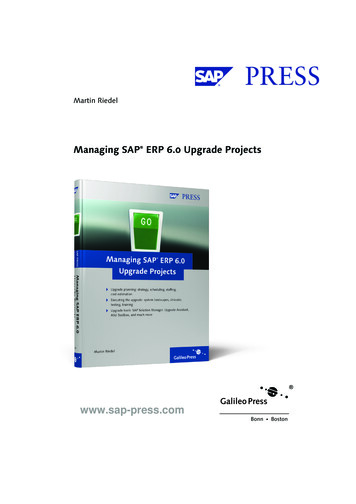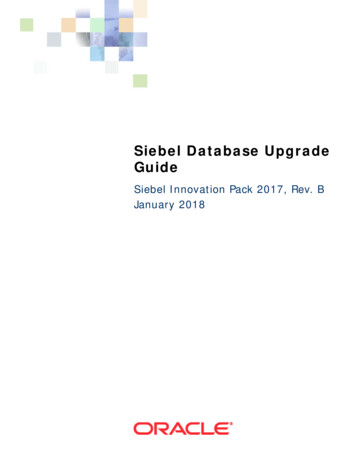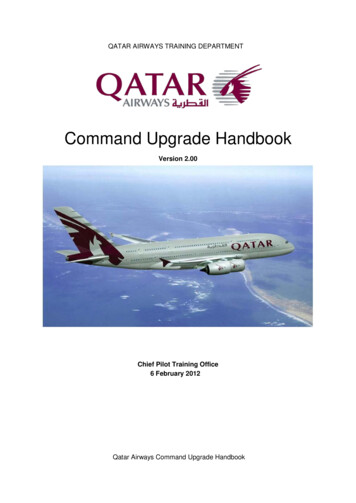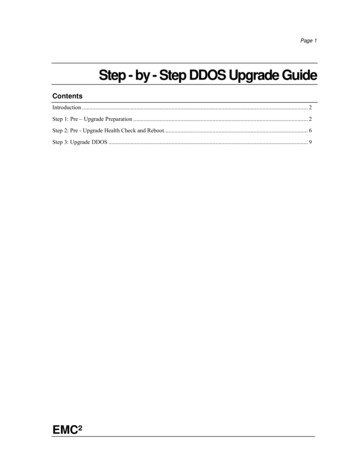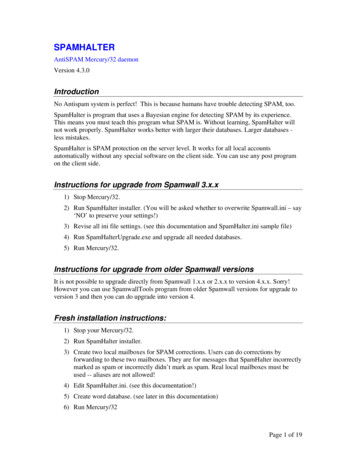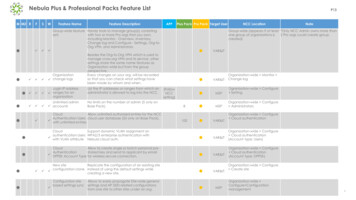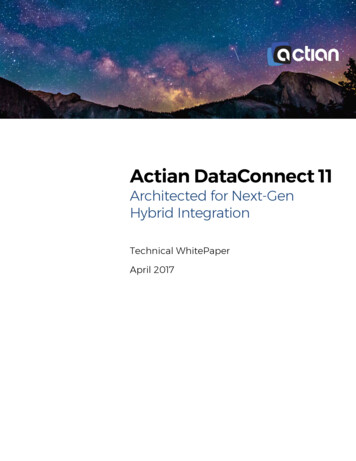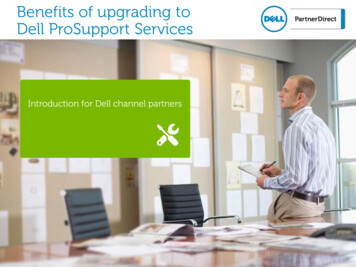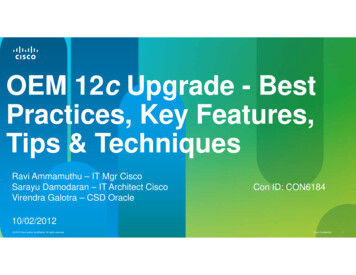
Transcription
Version 11.2Platform Upgrade and Migration Guide
Platform Upgrade and Migration GuideDocument VersionOCP11.2 MIGRATIONv1 10/22/15CopyrightCopyright 1997, 2016 Oracle and/or its affiliates. All rights reserved.This software and related documentation are provided under a license agreement containing restrictions on use and disclosure and areprotected by intellectual property laws. Except as expressly permitted in your license agreement or allowed by law, you may not use, copy,reproduce, translate, broadcast, modify, license, transmit, distribute, exhibit, perform, publish, or display any part, in any form, or by anymeans. Reverse engineering, disassembly, or decompilation of this software, unless required by law for interoperability, is prohibited.The information contained herein is subject to change without notice and is not warranted to be error-free. If you find any errors, pleasereport them to us in writing.If this is software or related documentation that is delivered to the U.S. Government or anyone licensing it on behalf of the U.S. Government,the following notice is applicable:U.S. GOVERNMENT END USERS: Oracle programs, including any operating system, integrated software, any programs installed on thehardware, and/or documentation, delivered to U.S. Government end users are “commercial computer software” pursuant to the applicableFederal Acquisition Regulation and agency-specific supplemental regulations. As such, use, duplication, disclosure, modification, andadaptation of the programs, including any operating system, integrated software, any programs installed on the hardware, and/ordocumentation, shall be subject to license terms and license restrictions applicable to the programs. No other rights are granted to the U.S.Government.This software or hardware is developed for general use in a variety of information management applications. It is not developed or intendedfor use in any inherently dangerous applications, including applications that may create a risk of personal injury. If you use this software orhardware in dangerous applications, then you shall be responsible to take all appropriate fail-safe, backup, redundancy, and other measuresto ensure its safe use. Oracle Corporation and its affiliates disclaim any liability for any damages caused by use of this software or hardware indangerous applications.Oracle and Java are registered trademarks of Oracle and/or its affiliates. Other names may be trademarks of their respective owners.Intel and Intel Xeon are trademarks or registered trademarks of Intel Corporation. All SPARC trademarks are used under license and aretrademarks or registered trademarks of SPARC International, Inc. AMD, Opteron, the AMD logo, and the AMD Opteron logo are trademarks orregistered trademarks of Advanced Micro Devices. UNIX is a registered trademark of The Open Group.This software or hardware and documentation may provide access to or information about content, products, and services from third parties.Oracle Corporation and its affiliates are not responsible for and expressly disclaim all warranties of any kind with respect to third-partycontent, products, and services unless otherwise set forth in an applicable agreement between you and Oracle. Oracle Corporation and itsaffiliates will not be responsible for any loss, costs, or damages incurred due to your access to or use of third-party content, products, orservices, except as set forth in an applicable agreement between you and Oracle.For information about Oracle’s commitment to accessibility, visit the Oracle Accessibility Program website athttp://www.oracle.com/pls/topic/lookup?ctx acc&id docacc.Access to Oracle Support: Oracle customers that have purchased support have access to electronic support through My Oracle Support. Forinformation, visit http://www.oracle.com/pls/topic/lookup?ctx acc&id info or visit http://www.oracle.com/pls/topic/lookup?ctx acc&id trsif you are hearing impaired.
µPlatform Upgrade and Migration GuideContents1Introduction1The CIM Migration ToolNew in Oracle Commerce 11.2112Migration Overview23Pre-Migration Task Checklist34Install Oracle Commerce Platform 11.24Version Compatibility5Run the CIM Migration Tool65Migration from Older ReleasesMigrating from Releases Before 10.2Data MigrationThe importConfig UtilityCIM Command Line OptionsMigration Kit LocationStarting CIM MigrationConfiguring datasourcesImport Initial Data6Manual Migration TasksExecuting Clean Up ScriptsUpdating View MappingsATG Search Tables7Application-Specific Post Migration StepsOracle Commerce Core Commerce NotesFractional Units ChangesConfigurator Framework ChangesOracle Commerce Core on Task Checklist229Migration Testing23iiiContents
Platform Upgrade and Migration Guideµ1 IntroductionThis guide describes how to upgrade from Oracle ATG Web Commerce 10.2, or later versions to OracleCommerce Platform 11.2. It is written for programmers, DBAs, site administrators, and partners.Before you begin migration:1.Check the Supported Environments information on the My Oracle Support Web site.Make sure you are running on a supported version of your application server, JDK,database server, and JDBC driver.2.Review the Migration Overview chapter.This guide uses the convention ATGdir to represent the installation directory for ATG products. Bydefault, the Windows installation creates the installation directory C:\ATG\ATG11.2, but this location canvary in your installation.For detailed information about Oracle Commerce Platform products, see the Oracle Commerce Platformdocumentation on the Oracle Technology Network Web site.Important: You must upgrade your entire Oracle Commerce Platform installation; you cannot upgradeonly part of it. Oracle does not support running different versions of Oracle Commerce Platform productstogether. For example, using the 11.2 Oracle Commerce Platform with an older version of CommerceService Center is not supported. The platform and all applications must have the same release number.If you are performing a migration over more than two releases, you will need to review any exportedscripts and reviews logs for any errors after each migration.The CIM Migration ToolMuch of the migration process is performed by the Configuration and Installation Manager (CIM)Migration Tool, which automates schema and data migration based on your current installation andinstalled migration kits.New in Oracle Commerce 11.2For information on the features in this release, refer to the Oracle Commerce Version 11.2 What’s NewReference knowledge article on My Oracle Support.11 - Introduction
µPlatform Upgrade and Migration Guide2 Migration OverviewTo migrate from Oracle ATG Web Commerce 10.2, 11.0, or 11.1 to Oracle Commerce Platform 11.2, followthese steps:1.Pre-Migration Task Checklist.2.Install Oracle Commerce Platform 11.2.3.Run the CIM Migration Tool.4.Complete Manual Migration Tasks.5.Complete Application-Specific Post Migration Steps.6.Complete Migration Testing.Each of these steps is detailed in the following chapters.22 - Migration Overview
Platform Upgrade and Migration Guideµ3 Pre-Migration Task ChecklistBefore starting migration, complete these tasks:1.Back up your Oracle Commerce Platform database.2.Back up all of your Publishing and PublishingAgent directories --for example,these CIM-generated directories under ATG11dir /home/servers/: atg publishing lockserver/Publishing atg production lockserver/PublishingAgentYou should also back up the ATG11dir /home/Publishing directory.3.If your installation includes ATG Content Administration, complete all projects.4.Process all reporting event logs. On the data warehouse load server, execute theloadAllAvailable method on all loaders in/atg/reporting/datawarehouse/loaders/.5.Shut down all Oracle Commerce servers.6.Shut down any search engines your environment uses.7.Remove Oracle Commerce artifacts, such as server instances, EAR files, and datasources, from the application server.Note: In addition to the tasks listed here, some applications may have their own requirements. Beforestarting the migration, review the instructions for each installed application, under Application-SpecificPost Migration Steps.33 - Pre-Migration Task Checklist
µPlatform Upgrade and Migration Guide4 Install Oracle Commerce Platform11.2The next steps in the migration process are to install Oracle Commerce Platform 11.2, obtain theresources required for the migration process, and configure your environment.1.Install Oracle Commerce Platform 11.2 as directed in the Installation and ConfigurationGuide.2.If you are migrating from releases earlier than 10.2, download the required migrationkits for each of those releases and migrate them separately until you have migrated torelease 10.2.If you are migrating from 10.2, or 11.0, or 11.1 to 11.2, you only need to downloadOCPlatform112MigrationKit and optionally OCServiceCenter112MigrationKit.If you are using Commerce Service Center modules, downloadOCServiceCenter112MigrationKit in addition to theOCPlatform112MigrationKit.Copy the files to ATGdir and unpack the kits, which creates the ATGdir \migration directory.Note: If you use both the Oracle Commerce Platform and the Oracle CommerceService Center modules, you must unpack both kits before starting your schemamigration since both the modules are migrated in one step.3.If you are using an MSSQL database, delete all MSSQL script files that containinternational data. For example: ATGdir \migration\11.0to11.2\ARF\DW\base\sql\db components\mssql\arf rpd i18n init XXX.sql ATGdir \migration\11.1to11.2\ARF\DW\Endeca\sql\db components\mssql\arf search datawarehouse i18n init xxx.sql ATGdir \migration\11.1to11.2\DCS\DW\sql\db components\mssql\arf dcs i18n init xxx.sqlAlternatively, you can leave a single script file for each language, assuming that yourdatabase is capable of supporting that language.4.Copy your existing configuration files and application modules to the OracleCommerce Platform 11.2 installation. Update application code as necessary toconform to new Oracle Commerce Platform 11.2 functionality. For more information,see the Application-Specific Post Migration Steps chapter.Note: Commerce Reference Store and the reference applications do not migrate.5.Copy the directories listed from your older (10.2-11.1) installation into your OracleCommerce Platform 11.2 installation:44 - Install Oracle Commerce Platform 11.2
Platform Upgrade and Migration ers/atg svcagent lockserver/publishing/home/servers/atg production lockserver/PublishingAgent/home/servers/atg svcagent lockserver /PublishingAgent/home/servers/atg staging/PublishingAgent6.If you use a Publishing Web Agent server, copy /home/PublishingWebAgent fromyour older (10.2-11.1) installations to your Oracle Commerce Platform 11.2 installation.Version CompatibilityBefore you begin installation of Oracle Commerce Platform 11.2, see the Oracle Commerce SupportedEnvironments document in the My Oracle Support knowledge base (https://support.oracle.com/).54 - Install Oracle Commerce Platform 11.2
µPlatform Upgrade and Migration Guide5 Run the CIM Migration ToolThe CIM Migration Tool is a utility that automates schema and data migration based on migration kits youinstall.Migration from Older ReleasesWith this version of the CIM Migration Tool, you can migrate from older versions (10.2 and later),migrating sequentially one release at a time.Migrating from Releases Before 10.2If you are migrating from releases earlier than 10.2, download the related kits and perform migrationsnecessary to bring your installation to the 10.2 release using the instructions in the related migrationguides. After you have migrated to 10.2, follow this guide to complete the migration to 11.2.Data MigrationData migration is not part of the Oracle Commerce Platform 11.1 to Oracle Commerce Platform 11.2migration and running the CIM data migration option will not perform a data migration action. Reviewthe Migration documentation for each release for more details.The importConfig UtilityBefore running the CIM Migration Tool, you can use the importConfig utility to identify which productsand add-ons were installed in your previous installation, otherwise you will need to manually select themin the CIM Migration tool. Before running this utility verify that in your environment DYNAMO HOMEreflects your ATG11.2 installation folder.Note: Your previous installation directory must be available to use the importConfig utility.Command Line Usage ATGdir \bin\importConfig.sh bat [previous platform location]Utility ResultsWhen you run the importConfig utility, this file is created: ATGdir \CIM\data\import.xml65 - Run the CIM Migration Tool
Platform Upgrade and Migration GuideµWhen the CIM Migration Tool runs, import.xml provides information on products and add-ons fromprevious installations which are listed in the migration information section.CIM Command Line OptionsStart the CIM Migration Tool from the command line. The following options are available:cim.sh bat [-m MODULELIST] [-debug] [-record] [-noencryption] [-batchinputFilePath] [-migration] [-migrationpath migrationKitsBasePath]Other optionsOptionDescription-migrationBegins the migration process.-debugEnables debug mode.-recordRecords the CIM options you selected and at the end of the migration, savesthe recorded file to a location you specify.-noencryptionWorks with record option. Normally the CIM options are recorded in encryptedform. If you use this option, they are written a readable form.-batchRuns the recorded file you specify, completing the migration automatically,without any manual intervention.-mSpecifies specific modules, such as DAS, DPS, etc.Migration Kit LocationThe default path for the migration kits is, for example: ATGdir \migration\11.1to11.2If you have unpacked the migration kit or kits to ATGdir \migration\11.0to11.1 you can use theunqualified CIM command:cim.sh bat -migrationOtherwise, specify the kit location. For example:cim.sh bat -migration -migrationpath \oracle\migration75 - Run the CIM Migration Tool
µPlatform Upgrade and Migration GuideStarting CIM MigrationWhen you start CIM with the –migration switch, the Migration Utility task appears on the menu,for example: CIM MAIN MENU enter [h]Help, [q]Quit to exitChoose the task you want to perform:[R]*[A]Set the Administrator Password - Done (pending database import)Select Application Server[M]Migration Utility[C]Custom CIM Plugin LauncherNote: When the –migration switch is used, the tasks Product Selection and DatabaseConfiguration do not display.Choose M to start the migration process. After you select Migration Utility, CIM displays the all theversions which are compatible for migration to the current release, for example:-------MIGRATION SOURCE ------enter [h]Help, [m]Main Menu, [q]Quit to exitChoose the version you are migrating from:[1]10.2[2]11.0[3]11.1Select one After making your selection, the following menu displays:-------PRODUCT ---------------enter [h]Help, [m]Main Menu, [q]Quit to exit*[P]Product Selection 85 - Run the CIM Migration Tool
µPlatform Upgrade and Migration GuideChoose all the products and add-ons that you have installed, then select Product Selection in menuand then select Continue when the WARNING message displays.Note: Partial migration may cause the software to malfunction and is not permitted. You must migrate allmodules.If you have run the importConfig utility before running cim, the products and add-ons from theprevious installation are selected by default in the available options.CIM then displays a list of the installed products and add-ons that can be migrated, for example:-------PRODUCT --------------enter [h]Help, [m]Main Menu, [q]Quit to exitSelect product you wish to configure by entering the corresponding item number.(Searching for products. done.)Migration information: following products were found in previous installation:Oracle Commerce Core CommerceContent AdministrationChoose one of the following options: (* Currently selected )[1]Oracle Commerce Platform Includes, optionally, data warehouse components[2]Oracle Commerce REST RESTful Web Services[3]Oracle Commerce WebCenter Sites Extensions Includes Commerce Platform and Commerce CAS Reader.[4]Oracle Commerce Site Administration Includes Commerce Platform and Content Administration[5]Oracle Commerce Platform-Guided Search Integration Includes Commerce Platform. Select this option when Commerce GuidedSearch is used.*[6]Content Administration Includes Oracle Commerce Platform.*[7]Optional: PreviewOracle Commerce Core Commerce Includes Commerce Platform and Content Administration. Optional: datawarehouse components, Preview and Merchandising UI[8]Oracle Commerce CAS Reader Includes Commerce Platform. Select this option when Commerce Platformis used to import data to Commerce CAS.95 - Run the CIM Migration Tool
µPlatform Upgrade and Migration Guide[9]Oracle Commerce Service Center Agent-facing commerce application[D]DoneSelect one or more In this menu and those that follow, select the products and add-ons you want to migrate and themigration tool will update the schema and import data. When your selection is complete, the Migrationoption displays:-------PRODUCT ---------------enter [h]Help, [m]Main Menu, [q]Quit to exit[P]*[C]Product Selection - DoneMigration Selection When the Product Selection is complete, choose option C to proceed with migration process and thefollowing screen displays:-------MIGRATION ------------enter [h]Help, [m]Main Menu, [q]Quit to exitChoose the Migration task you want to perform:*[1]10.2 - 11.0[2]11.0 - 11.1[3]11.1 - 11.2Select one After selecting a migration step, the following screen displays:-------DATABASE MIGRATION ---enter [h]Help, [m]Main Menu, [q]Quit to exit*[D][C]Database MigrationCancel Choose D to begin the Data Migration process, which is described in the following section.105 - Run the CIM Migration Tool
Platform Upgrade and Migration GuideµConfiguring datasourcesIn the next step, you will need to choose and configure the named datasource for each server you areusing. For example, the following example shows the servers that may be migrated by choosing therelated datasource:*[1]Reporting Data Warehouse[2]Reporting Loader[3]Publishing[4]Production Core[5]Agent Datasource[D]DoneSelect one Select the server you want to migrate, for example, Reporting Loader:-------CONFIGURE DATASOURCE REPORTING LOADER----enter [h]Help, [m]Main Menu, [q]Quit to exit[C]Connection Details[T]Test Connection[E]Export Database Migration Script[S]Migrate Schema[D]Migrate Data[X]Export Database Cleanup Script[L]Cleanup Schema[O]Configure Another DatasourceAfter you have provided connection details, you may optionally test the connection by choosing TestConnection. Once you verify that you can to connect to the database schema, for each server completethe following steps:1.Export Database Migration Scripts. You must complete this step because theexported scripts are used to migrate the schema. After exporting the migration scripts,review the scripts and customize them, if needed for your environment.2.Migrate Schema. After customizing the scripts, execute them by selecting the MigrateSchema option. When this completes, review the cim.log that has been created in ATGdir /cim/log for any errors.3.Migrate data. Complete this step if data needs to be migrated.4.Export Database Cleanup Scripts. These scripts list the tables that are no longerneeded and would be dropped if you ran Cleanup Schema. Review the exportedscripts before running Cleanup Schema. Make a copy the contents of the listed tablesif you need to save the data.5.Cleanup Schema. Execute the clean up scripts by choosing Cleanup Schema. Executethis step only when you are ready to drop the tables that are no longer needed. It isnot necessary to carry out this step before moving to migrate another server anddatasource.115 - Run the CIM Migration Tool
µPlatform Upgrade and Migration GuideNote: If you are migrating over more than two releases, start with the earliest version and migrate to thenext newest version till you reach the current release. After each migration review any exported scriptsand review the CIM logs for any errors. The main purpose of the exports are described in the followingsection, which will help you understand which DDLs are going to be executed as part of each migrationand to provide the opportunity to make any changes necessary for your environment.Import Migration DataAfter you have migrated schemas, the Import Migration Data task imports migration data for theapplications you are configuring.Note that the data migration function is not part this release (Oracle Commerce Platform 11.1 to OracleCommerce Platform 11.2). Running the CIM data migration option will not perform a data migrationaction for the 11.1 to 11.2 migration.However, if you are migrating from version earlier than Oracle Commerce Platform 11.1, data migrationwill be completed for those versions. See the Migration documentation for each release for more details.Import Initial DataAfter all of your selected migration steps for each selected release are successful, the menu item ImportInitial Data displays on the Migration Utility menu, for example:Choose the Migration task you want to perform:*[1]10.2 - 11.0[2]11.0 - 11.1[3]11.1 - 11.2[I] Import Initial DataSelect one This step executes the startSQLRepository imports that are required for migration, run these importsin the required order.125 - Run the CIM Migration Tool
µPlatform Upgrade and Migration Guide6 Manual Migration TasksThere are some migration tasks that are not performed by the CIM Migration Tool. You must manuallyperform these after running the CIM Migration Tool to complete the update process.Executing Clean Up ScriptsAfter completing the migration of database schema for the servers described in the previous steps,execute the following clean up scripts based on your installed environment:For the DCS.DW.Search ModuleOracle ATGdir \migration\10.2to11.0\DCS\DW\Search\sql\db components\oracle\dcs dw search.bat sh schema owner password tns aliasDB2 ATGdir \migration\10.2to11.0\DCS\DW\Search\sql\db components\db2\dcs dw search.bat sh schema owner password db2 aliasMSSQL ATGdir \migration\10.2to11.0\DCS\DW\Search\sql\db components\mssql\dcs dwsearch.bat schema owner password hostname db schemaThese scripts execute dcs srch ddl cleanup.sqlFor DCS.DW moduleOracle ATGdir \migration\10.2to11.0\DCS\DW\sql\db components\oracle\dcs dw.bat sh schema owner password tns aliasDB2 ATGdir \migration\10.2to11.0\DCS\DW\sql\db components\db2\dcs dw.bat shschema owner password db2 aliasMSSQL ATGdir \migration\10.2to11.0\DCS\DW\sql\db components\mssql\dcs dw. batschema owner password hostname db schemaThis script executes: arf dcs ddl cleanup.sql136 - Manual Migration Tasks
µPlatform Upgrade and Migration GuideDCS.Search.Versioned ModuleOracle ATGdir \migration\10.2to11.0\DCS\Search\Versioned\sql\db components\oracle\versioned dcs search.bat sh schema owner password tns aliasDB2 ATGdir \migration\10.2to11.0\DCS\Search\Versioned\sql\db components\db2\versioned dcs search.bat sh schema owner password db2 aliasMSSQL ATGdir \migration\10.2to11.0\DCS\Search\Versioned\sql\db components\mssql\versioned dcs search.bat schema owner password hostname db schemaThis script executes:versioned commerce refinement ddl cleanup.sqlversioned custom catalog refinement ddl cleanup.sqARF.DW.Search ModuleOracle ATGdir \migration\10.2to11.0\ARF\DW\Search\sql\db components\oracle\arf dw search.bat sh schema owner password tns aliasDB2 ATGdir \migration\10.2to11.0\ARF\DW\Search\sql\db components\db2\arf dw search.bat sh schema owner password db2 aliasMSSQL ATGdir \migration\10.2to11.0\ARF\DW\Search\sql\db components\mssql\arf dwsearch.bat schema owner password hostname db schemaThese scripts execute:search datawarehouse view ddl cleanup.sqlsearch datawarehouse ddl cleanup.sqlARF.DW.base ModuleOracle ATGdir \migration\10.2to11.0\ARF\DW\base\sql\db components\oracle\arf dwbase.bat sh schema owner password tns aliasDB2 ATGdir \migration\10.2to11.0\ARF\DW\base\sql\db components\oracle\arf dwbase.bat sh schema owner password db2 aliasMSSQL ATGdir \migration\10.2to11.0\ARF\DW\base\sql\db components\oracle\arf dwbase.bat schema owner password hostname db schema146 - Manual Migration Tasks
Platform Upgrade and Migration GuideµDAF.Search.TopicsOracle ATGdir \migration\10.2to11.0\DAF\Search\Topics\sql\db components\oracle\daf search topics.bat schema owner password tns aliasDB2 ATGdir \migration\10.2to11.0\DAF\Search\Topics\sql\db components\db2\dafsearch topics.bat shschema owner password db2 aliasMSSQL ATGdir \migration\10.2to11.0\DAF\Search\Topics\sql\db components\mssql\daf search topics.bat schema owner password hostname db schemaThese scripts execute search topics ddl cleanup.sqlUpdating View MappingsAfter you run the appropriate migration scripts for your environment, you must update your viewmappings.Note: All custom view mappings must be migrated after you complete the steps below.Before importing any view mappings, configure the data sources used by the import utility. Configure 0074aSource.properties file to refer toyour publishing schema, and another with the name FakeXADataSource production.properties foryour production schema. An example FakeXADataSource file that refers to the publishing schemafollows: class atg.service.jdbc.FakeXADataSourcedriver oracle.jdbc.OracleDriverURL jdbc:oracle:thin:@your host name:1521:utf8112user usernamepassword passwordIf you use switching data sources, configure the following files: FakeXADataSource switchA.properties to refer to your SwitchingA schema. FakeXADataSource switchB.properties to refer to your SwitchingB schema. SwitchingDataSourceA.properties to refer to yourFakeXADataSource switchA.properties file. SwitchingDataSourceB.properties to refer to yourFakeXADataSource switchB.properties file.For example: class atg.service.jdbc.MonitoredDataSourcedataSource /atg/dynamo/service/jdbc/FakeXADataSource switchA156 - Manual Migration Tasks
µPlatform Upgrade and Migration GuideRun the following scripts on the Asset Management servers for all products:/bin/startSQLRepository -m BIZUI itory –import" ATGdir rtSQLRepository -m BCC ory -import" ATGdir SQLRepository -m ContentMgmt-UI itory –import" ATGdir l"bin/startSQLRepository -m DPS-UI ory -import" ATGdir ing.xml"bin/startSQLRepository -m DPS-UI ory -import " ATGdir rtSQLRepository -m AssetUI ory -import" ATGdir tartSQLRepository -m AssetUI ory -import" ATGdir "bin/startSQLRepository -m SiteAdmin.Versioned ory -import" ATGdir ng.xml"bin/startSQLRepository -m DPS-UI.Versioned ory -import " ATGdir ml"bin/startSQLRepository -m DPS-UI.Versioned ory -import " ATGdir bin/startSQLRepository -m DCS-UI ory -import " ATGdir rtSQLRepository -m DCS-UI.Versioned ory -import " ATGdir ml"bin/startSQLRepository -m DCS-UI.SiteAdmin.Versioned ory -import " ATGdir wmapping.xml"Important: Run the following three scripts only if you installed and configured a preview server on yourAsset Management server. These import scripts configure some view mapping components specificallyfor preview and require the preview layer. (For more information, see Migration Testing.)166 - Manual Migration Tasks
µPlatform Upgrade and Migration Guidebin/startSQLRepository -m DPS-UI ory -import " ATGdir /home/./DPSUI/install/data/viewmapping preview.xml"bin/startSQLRepository -m SiteAdmin.Versioned ory -import" ATGdir ng preview.xml"bin/startSQLRepository -m DCS-UI ory -import " ATGdir /home/./DCSUI/install/data/viewmapping preview.xml"Important: Run the following script only if you enabled SSO on your Asset Management server.bin/startSQLRepository -m DPS-UI itory –import" ATGdir mappin
Data migration is not part of the Oracle Commerce Platform 11.1 to Oracle Commerce Platform 11.2 migration and running the CIM data migration optionwill not perform a data migration action. Review the Migration documentation for each release for more details.
